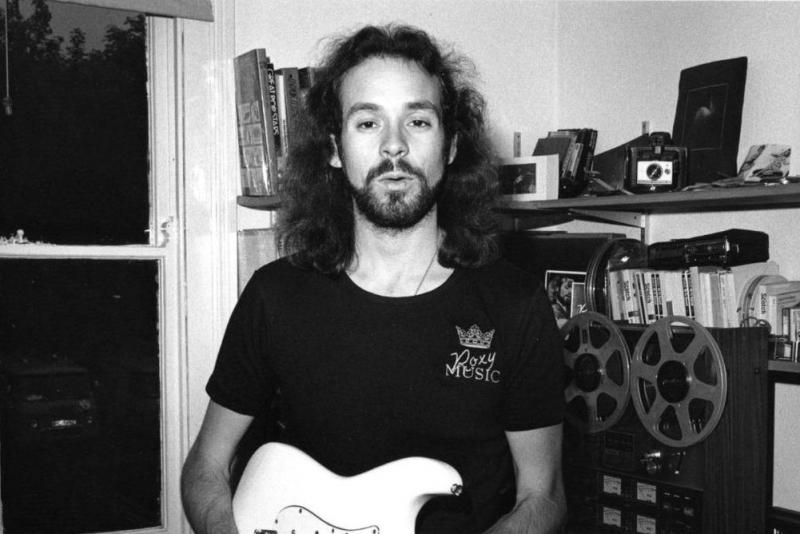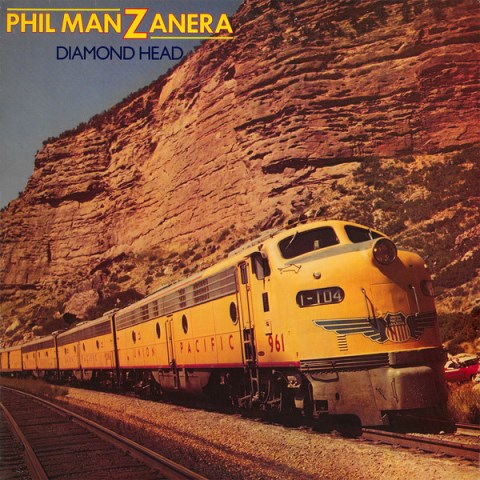Reissue CDs Weekly: Phil Manzanera - Diamond Head | reviews, news & interviews
Reissue CDs Weekly: Phil Manzanera - Diamond Head
Reissue CDs Weekly: Phil Manzanera - Diamond Head
Roxy Music man’s overlooked first solo album is a winner

Diamond Head was Roxy Music guitarist Phil Manzanera’s first solo album. Released in May 1975 and recorded the previous December and January during a lull in his parent band’s activities, it hit shops between Roxy’s Country Life and Siren albums. Singer Bryan Ferry had done a short solo tour in December 1974 which culminated with a show at The Royal Albert Hall where he was backed by an orchestra.
Playing alongside him on Diamond Head were Eddie Jobson, Andy Mackay, Paul Thompson and John Wetton – sans Ferry, Manzanera assembled the whole of the then-current Roxy line-up. Brian Eno was also on board. He had left Roxy in July 1973. Others gathered in the studio with Manzanera included bassist and Eno-associate Brian Turrington (from The Winkies), Bill MacCormick (who had been on Eno’s Here Come The Warm Jets album in 1973) and Robert Wyatt (MacCormick played with him in Matching Mole and had been in Manzanera’s pre-Roxy band Quiet Sun).
 As well as being a quasi-Roxy Music album, the newly reissued Diamond Head gathered some of British art-rock’s heavy hitters. But it has not received much attention. It was recorded concurrently with an album by the reformed Quiet Sun which was released in August 1975, so it’s fair to wonder whether Manzanera was staking his claim as a pivotal figure in the more leftfield areas of British rock. He later said “unbeknownst to my management company I recorded two albums in the studio time allocated for one album.”
As well as being a quasi-Roxy Music album, the newly reissued Diamond Head gathered some of British art-rock’s heavy hitters. But it has not received much attention. It was recorded concurrently with an album by the reformed Quiet Sun which was released in August 1975, so it’s fair to wonder whether Manzanera was staking his claim as a pivotal figure in the more leftfield areas of British rock. He later said “unbeknownst to my management company I recorded two albums in the studio time allocated for one album.”
Roxy were one aspect of Manzanera’s already top-notch CV. His first production credit had been a joint one with Eno on John Cale’s 1974 Fear album. The partnership continued that year for Eno’s Taking Tiger Mountain (By Strategy) album. He also played on Ferry’s first solo album, 1973’s These Foolish Things, and Mackay’s 1974 oddity In Search of Eddie Riff but Manzanera carried the can on Diamond Head.
One track, the dramatic “East Of Echo” is by and credited to Quiet Sun. Obviously there was a bleed between the different hats Manzanera was wearing; on his solo album he pointed to another aspect of what he was doing. The real jolt arrives with the extraordinary “Miss Shapiro” (an oblique cut-up lyric tribute to Helen?), an Eno-sung, Eno-Manzanera co-write with elements of Roxy’s “The Numberer” which would have comfortably slotted onto Eno’s first two solo albums: another bleed. The same goes for the also-terrific “Big Day”.
 Once the surprise of discovering these Eno-slanted outings wears off, it becomes impossible not to reconsider Manzanera’s role in both Roxy and Eno’s early solo work. His role as a prime artistic enabler and mover needs recognising. Further proof of this comes with Diamond Head’s lovely, soaring opening track, “Frontera”. Sung in Spanish by Robert Wyatt as a nod to Manzanera’s background, it has a dreaminess nodding forward to the sound of reformed Roxy Music of August 1978 and later. That it was the solitary album track extracted as a single and issued only in Germany confirms that the solo Manzanera wasn’t seen as a commercial goer.
Once the surprise of discovering these Eno-slanted outings wears off, it becomes impossible not to reconsider Manzanera’s role in both Roxy and Eno’s early solo work. His role as a prime artistic enabler and mover needs recognising. Further proof of this comes with Diamond Head’s lovely, soaring opening track, “Frontera”. Sung in Spanish by Robert Wyatt as a nod to Manzanera’s background, it has a dreaminess nodding forward to the sound of reformed Roxy Music of August 1978 and later. That it was the solitary album track extracted as a single and issued only in Germany confirms that the solo Manzanera wasn’t seen as a commercial goer.
In the reissue's liner notes, the Manzanera of the time is quoted as saying “The things I wanted to do are all there; the little cameos like the dance number, the three minute type guitar instrumental, the classical number. Certain of the songs were written with suitable people in mind and eventually it all came off.” That “guitar instrumental” “Lagrima” is especially interesting as it features Andy McKay’s oboe and suggests where Roxy’s “The Pride and the Pain” may have gone next. As this confirms, Diamond Head is not stylistically cohesive.
Before Diamond Head’s release, Phil Manzanera was back in Roxy Music and on road with them in America over February and March 1975. He did not pursue the paths heard on Diamond Head. Mysteriously, for no given reason, the new reissue has a different cover image to the original album (pictured above) and is very washed out. However, give this a listen – it’s a treat.
- Next week: Creedence Clearwater Revival at Woodstock
- Read more reissue reviews on theartsdesk
- Kieron Tyler’s website
Explore topics
Share this article
The future of Arts Journalism
You can stop theartsdesk.com closing!
We urgently need financing to survive. Our fundraising drive has thus far raised £49,000 but we need to reach £100,000 or we will be forced to close. Please contribute here: https://gofund.me/c3f6033d
And if you can forward this information to anyone who might assist, we’d be grateful.

Subscribe to theartsdesk.com
Thank you for continuing to read our work on theartsdesk.com. For unlimited access to every article in its entirety, including our archive of more than 15,000 pieces, we're asking for £5 per month or £40 per year. We feel it's a very good deal, and hope you do too.
To take a subscription now simply click here.
And if you're looking for that extra gift for a friend or family member, why not treat them to a theartsdesk.com gift subscription?
more New music
 'The Art of Loving': Olivia Dean's vulnerable and intimate second album
Neo soul Londoner's new release outgrows her debut
'The Art of Loving': Olivia Dean's vulnerable and intimate second album
Neo soul Londoner's new release outgrows her debut
 Music Reissues Weekly: The Peanut Butter Conspiracy - The Most Up Till Now
Definitive box-set celebration of the Sixties California hippie-pop band
Music Reissues Weekly: The Peanut Butter Conspiracy - The Most Up Till Now
Definitive box-set celebration of the Sixties California hippie-pop band
 Doja Cat's 'Vie' starts well but soon tails off
While it contains a few goodies, much of the US star's latest album lacks oomph
Doja Cat's 'Vie' starts well but soon tails off
While it contains a few goodies, much of the US star's latest album lacks oomph
 Mariah Carey is still 'Here for It All' after an eight-year break
Schmaltz aplenty but also stunning musicianship from the enduring diva
Mariah Carey is still 'Here for It All' after an eight-year break
Schmaltz aplenty but also stunning musicianship from the enduring diva
 Album: Solar Eyes - Live Freaky! Die Freaky!
Psychedelic indie dance music with a twinkle in its eye
Album: Solar Eyes - Live Freaky! Die Freaky!
Psychedelic indie dance music with a twinkle in its eye
 Album: Night Tapes - portals//polarities
Estonian-voiced, London-based electro-popsters' debut album marks them as one to watch for
Album: Night Tapes - portals//polarities
Estonian-voiced, London-based electro-popsters' debut album marks them as one to watch for
 Album: Mulatu Astatke - Mulatu Plays Mulatu
An album full of life, coinciding with a 'farewell tour'
Album: Mulatu Astatke - Mulatu Plays Mulatu
An album full of life, coinciding with a 'farewell tour'
 Music Reissues Weekly: Sly and the Family Stone - The First Family: Live At Winchester Cathedral 1967
Must-have, first-ever release of the earliest document of the legendary soul outfit
Music Reissues Weekly: Sly and the Family Stone - The First Family: Live At Winchester Cathedral 1967
Must-have, first-ever release of the earliest document of the legendary soul outfit
 Album: Robert Plant - Saving Grace
Mellow delight from former Zep lead
Album: Robert Plant - Saving Grace
Mellow delight from former Zep lead
 Brìghde Chaimbeul, Round Chapel review - enchantment in East London
Inscrutable purveyor of experimental Celtic music summons creepiness and intensity
Brìghde Chaimbeul, Round Chapel review - enchantment in East London
Inscrutable purveyor of experimental Celtic music summons creepiness and intensity
 Album: NewDad - Altar
The hard-gigging trio yearns for old Ireland – and blasts music biz exploitation
Album: NewDad - Altar
The hard-gigging trio yearns for old Ireland – and blasts music biz exploitation
 First Person: Musician ALA.NI on how thoughts of empire and reparation influenced a song
She usually sings about affairs of the heart - 'TIEF' is different, explains the star
First Person: Musician ALA.NI on how thoughts of empire and reparation influenced a song
She usually sings about affairs of the heart - 'TIEF' is different, explains the star

Add comment